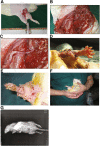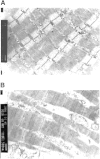Cryopreservation and replantation of amputated rat hind limbs
- PMID: 24886622
- PMCID: PMC4048362
- DOI: 10.1186/2047-783X-19-28
Cryopreservation and replantation of amputated rat hind limbs
Abstract
Background: In spite of the relatively high success rate of limb replantation, many patients cannot undergo replantation surgery because the preservation time of an amputated limb is only about six hours. In addition, although allotransplantation of composite tissues is being performed more commonly with increasingly greater success rates, the shortage of donors limits the number of patients that can be treated. So the purpose of this study is to examine the feasibility of cryopreservation and replantation of limbs in a rat model.
Methods: Twelve five-month-old Sprague-Dawley rats were divided evenly into group A (above-knee amputation) and group B (Syme's amputation). One hind limb was amputated from each rat. The limbs were irrigated with cryoprotectant, cooled in a controlled manner to -140°C, and placed in liquid nitrogen. Thawing and replantation were performed 14 days later.
Results: In group A, the limbs became swollen after restoration of blood flow resulting in blood vessel compression and all replantations failed. In group B, restoration of blood flow was noted in all limbs after replantation. In one case, the rat chewed the replanted limb and replantation failed. The other five rats were followed for three months with no abnormalities noted in the replanted limbs.
Conclusions: Limbs with a minimal amount of muscle tissue can be successfully cryopreserved and replanted.
Figures





Similar articles
-
Replantation of Cryopreserved Fingers: An "Organ Banking" Breakthrough.Plast Reconstr Surg. 2019 Sep;144(3):679-683. doi: 10.1097/PRS.0000000000005979. Plast Reconstr Surg. 2019. PMID: 31461026
-
Subzero nonfreezing preservation in a murine limb replantation model.J Orthop Sci. 1998;3(3):156-62. doi: 10.1007/s007760050036. J Orthop Sci. 1998. PMID: 9683769
-
[An experimental study of the effect of fluorocarbon perfusion for amputated limb preservation. The effect of inhibition for replantation toxemia and muscle tissue destruction].Nihon Seikeigeka Gakkai Zasshi. 1984 May;58(5):497-508. Nihon Seikeigeka Gakkai Zasshi. 1984. PMID: 6470549 Japanese.
-
Clinical guideline for vascularized composite tissue cryopreservation.J Tissue Eng Regen Med. 2021 Jun;15(6):527-533. doi: 10.1002/term.3190. Epub 2021 Apr 8. J Tissue Eng Regen Med. 2021. PMID: 33830654 Review.
-
Temporary Ectopic Implantation of an Amputated Leg Using the Distal Runoff Vessel of the Anterolateral Thigh Flap Followed by Subsequent Prefabricated Chimeric Replantation.Ann Plast Surg. 2019 Jan;82(1):71-75. doi: 10.1097/SAP.0000000000001630. Ann Plast Surg. 2019. PMID: 30285991 Review.
Cited by
-
Thermal Analyses of Nanowarming-Assisted Recovery of the Heart From Cryopreservation by Vitrification.J Heat Transfer. 2022 Mar 1;144(3):031202. doi: 10.1115/1.4053105. Epub 2022 Jan 18. J Heat Transfer. 2022. PMID: 35833152 Free PMC article.
-
Social, economic, and policy implications of organ preservation advances.Curr Opin Organ Transplant. 2018 Jun;23(3):336-346. doi: 10.1097/MOT.0000000000000532. Curr Opin Organ Transplant. 2018. PMID: 29683801 Free PMC article. Review.
-
Preoperative Cryopreservation Promotes Digital Survival after Digit Replantation.Comput Math Methods Med. 2022 Mar 7;2022:2003618. doi: 10.1155/2022/2003618. eCollection 2022. Comput Math Methods Med. 2022. Retraction in: Comput Math Methods Med. 2023 Sep 27;2023:9852759. doi: 10.1155/2023/9852759. PMID: 35295200 Free PMC article. Retracted. Clinical Trial.
-
Significantly Improved Cold Preservation of Rat Hind Limb Vascularized Composite Allografts Using the New PrC-210 Free Radical Scavenger.Int J Mol Sci. 2024 Jan 28;25(3):1609. doi: 10.3390/ijms25031609. Int J Mol Sci. 2024. PMID: 38338887 Free PMC article.
-
Digit Replantation Practice: A Comparison of Three Rat Models.J Hand Microsurg. 2021 Jan 7;15(1):37-40. doi: 10.1055/s-0040-1722537. eCollection 2023 Feb. J Hand Microsurg. 2021. PMID: 36761045 Free PMC article.
References
-
- Wang X, Chen H, Yin H, Kim SS, Lin Tan S, Gosden RG. Fertility after intact ovary replantation. Nature. 2002;415:385. - PubMed
Publication types
MeSH terms
Substances
LinkOut - more resources
Full Text Sources
Other Literature Sources

